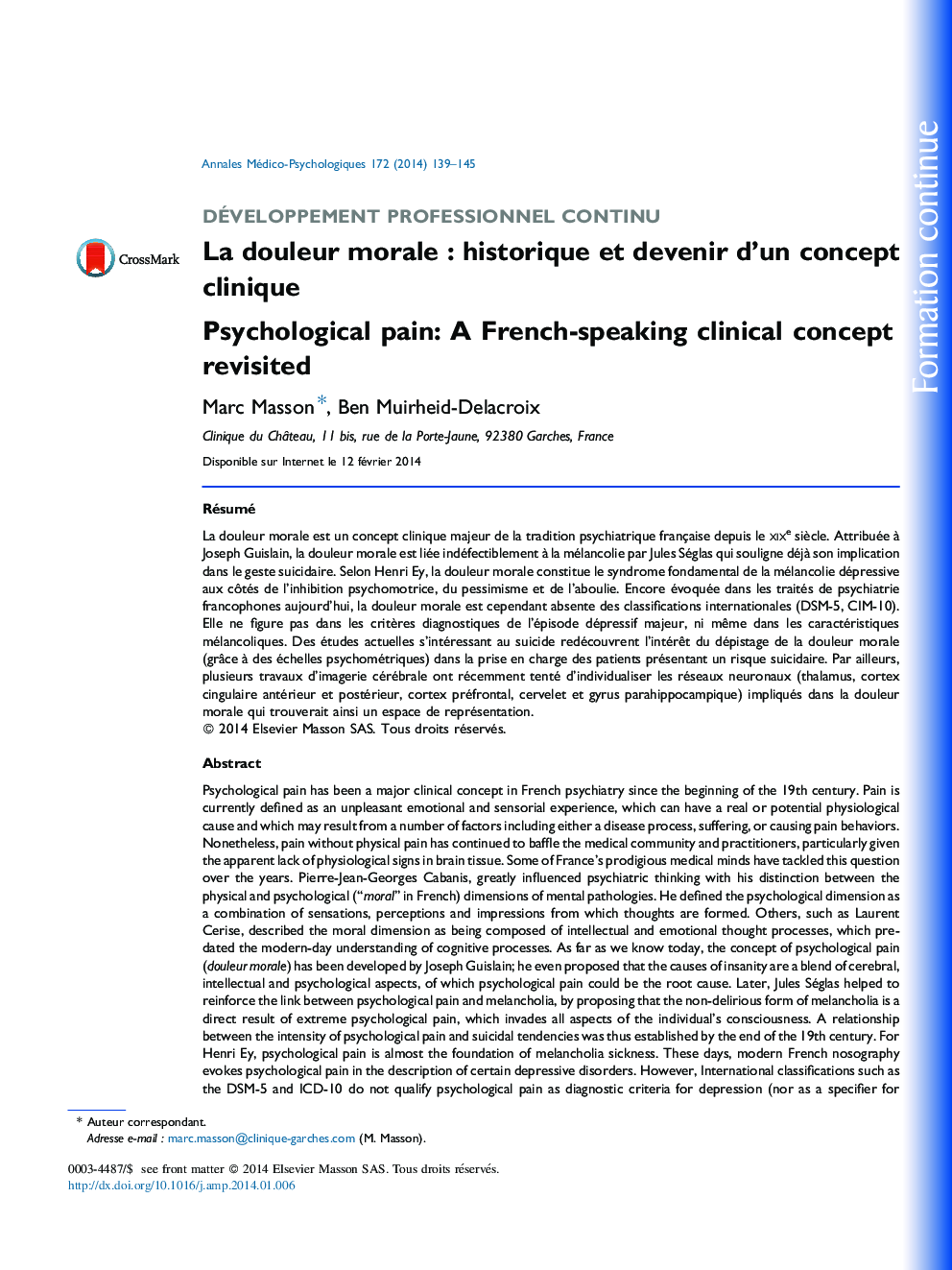| کد مقاله | کد نشریه | سال انتشار | مقاله انگلیسی | نسخه تمام متن |
|---|---|---|---|---|
| 312522 | 534223 | 2014 | 7 صفحه PDF | دانلود رایگان |
RésuméLa douleur morale est un concept clinique majeur de la tradition psychiatrique française depuis le xixe siècle. Attribuée à Joseph Guislain, la douleur morale est liée indéfectiblement à la mélancolie par Jules Séglas qui souligne déjà son implication dans le geste suicidaire. Selon Henri Ey, la douleur morale constitue le syndrome fondamental de la mélancolie dépressive aux côtés de l’inhibition psychomotrice, du pessimisme et de l’aboulie. Encore évoquée dans les traités de psychiatrie francophones aujourd’hui, la douleur morale est cependant absente des classifications internationales (DSM-5, CIM-10). Elle ne figure pas dans les critères diagnostiques de l’épisode dépressif majeur, ni même dans les caractéristiques mélancoliques. Des études actuelles s’intéressant au suicide redécouvrent l’intérêt du dépistage de la douleur morale (grâce à des échelles psychométriques) dans la prise en charge des patients présentant un risque suicidaire. Par ailleurs, plusieurs travaux d’imagerie cérébrale ont récemment tenté d’individualiser les réseaux neuronaux (thalamus, cortex cingulaire antérieur et postérieur, cortex préfrontal, cervelet et gyrus parahippocampique) impliqués dans la douleur morale qui trouverait ainsi un espace de représentation.
Psychological pain has been a major clinical concept in French psychiatry since the beginning of the 19th century. Pain is currently defined as an unpleasant emotional and sensorial experience, which can have a real or potential physiological cause and which may result from a number of factors including either a disease process, suffering, or causing pain behaviors. Nonetheless, pain without physical pain has continued to baffle the medical community and practitioners, particularly given the apparent lack of physiological signs in brain tissue. Some of France's prodigious medical minds have tackled this question over the years. Pierre-Jean-Georges Cabanis, greatly influenced psychiatric thinking with his distinction between the physical and psychological (“moral” in French) dimensions of mental pathologies. He defined the psychological dimension as a combination of sensations, perceptions and impressions from which thoughts are formed. Others, such as Laurent Cerise, described the moral dimension as being composed of intellectual and emotional thought processes, which pre-dated the modern-day understanding of cognitive processes. As far as we know today, the concept of psychological pain (douleur morale) has been developed by Joseph Guislain; he even proposed that the causes of insanity are a blend of cerebral, intellectual and psychological aspects, of which psychological pain could be the root cause. Later, Jules Séglas helped to reinforce the link between psychological pain and melancholia, by proposing that the non-delirious form of melancholia is a direct result of extreme psychological pain, which invades all aspects of the individual's consciousness. A relationship between the intensity of psychological pain and suicidal tendencies was thus established by the end of the 19th century. For Henri Ey, psychological pain is almost the foundation of melancholia sickness. These days, modern French nosography evokes psychological pain in the description of certain depressive disorders. However, International classifications such as the DSM-5 and ICD-10 do not qualify psychological pain as diagnostic criteria for depression (nor as a specifier for melancholic features), yet there are indeed references to “clinically significant distress” in major depressive episodes, and suicidal thinking linked to emotional states perceived as unending and excruciatingly painful. Consequently, these varying levels of conceptualization of psychological pain may have impeded its acceptance within the international psychiatric community as a distinct concept with its own well-defined specification. Nevertheless, recent literature research has shown an emergence of similar notions, including psychological suffering, moral pain, psychache, psychological pain, emotional pain, psychic pain, or mental pain. It now appears critical on an international scale to develop a clear definition for psychological pain in order to develop common ground for future research and, perhaps most importantly, to better understand suicidal tendencies in psychiatric patients, young and old alike. And finally, with the rapid development of modern neuro-science and brain imaging, scientists may now be capable of demystifying this subjective experience of psychological pain through objective data – thus rendering “visible” what was up to now “invisible” (Michel Foucault).
Journal: Annales Médico-psychologiques, revue psychiatrique - Volume 172, Issue 2, March 2014, Pages 139–145
